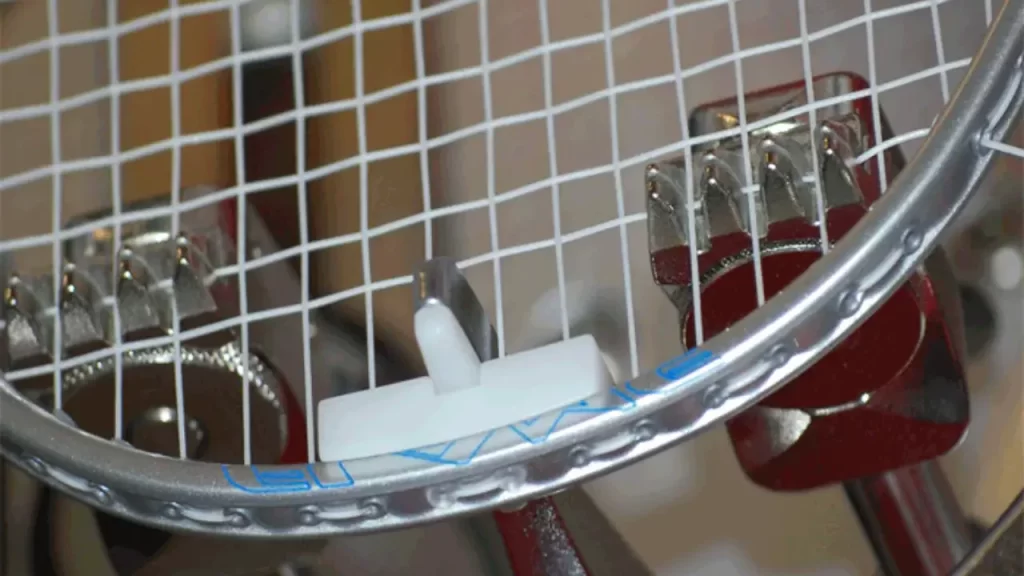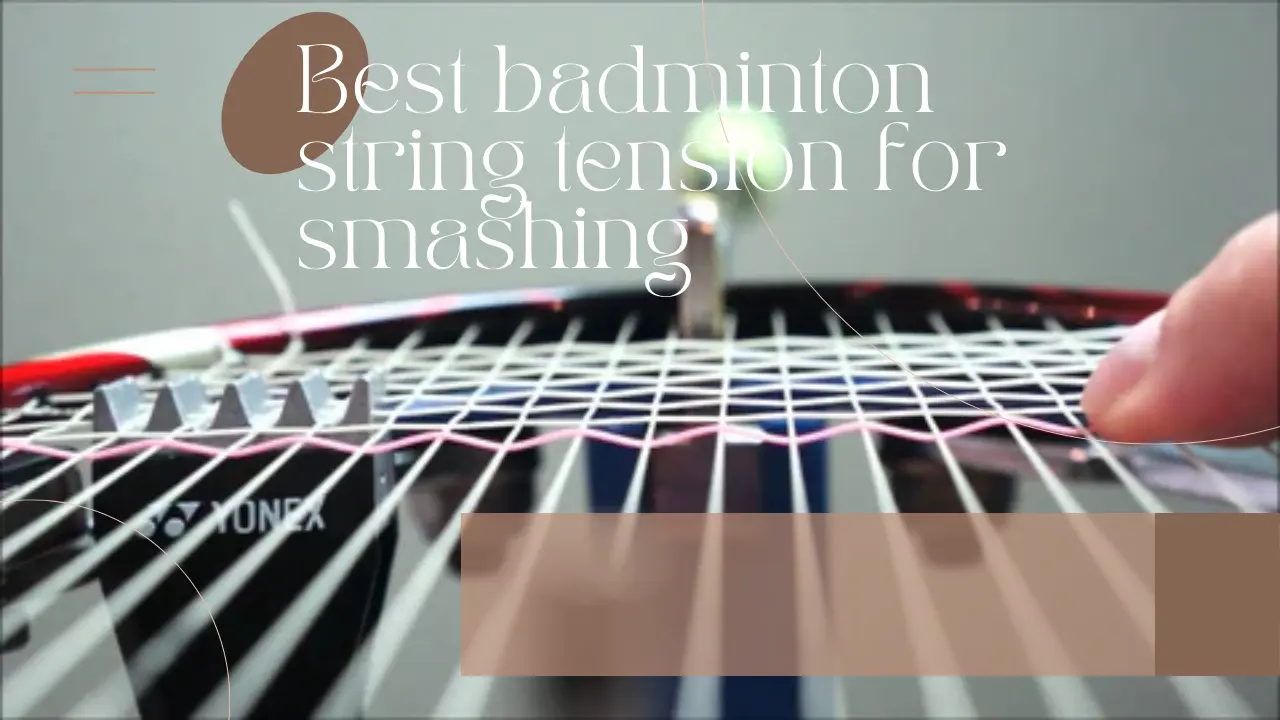If you play Badminton, you may have heard players talk about the tension they use on their rackets. Some can use 20 pounds (9.1 kg), and others can use something even passing 30 pounds (13.6 kg).
But which is the best badminton string tension for smashing? We will explore the question in this post and answer what, and maybe more important, why inevitable tensions are the best for you.
Beginner badminton players must use string tension between 18 and 22 LBS (8.2 and 10 kg). Medium badminton players must use string tension between 22 and 26 LBS (10 and 11.8 kg).
Sophisticated and professional players must use string tension higher than 25 pounds (11.3 kg) or whatever they feel is the most comfortable.
Note that using string tension outside the best badminton string tension for smashing range recommended by the racket – often done by sophisticated and professional players – will cancel the factory warranty, so do it with your risks.
Also, read this: Top 6 Best Badminton Shoes | Best Guide You Ever Need, 2022

What is a String Tension?
The best badminton string tension for smashing measures how much power is used to stretch the strings across the racket. The higher the force, the tighter strings. You can consider tension as the opposite of compression – which, on the contrary, is a measure of strength when pushing something inside rather than out.
String tension is usually measured in pounds (LBS) or kilograms (kg). As mentioned above, badminton rackets are usually hung between 18 and 27 lbs (8.2 and 12.2 kg); beginners prefer their strings to be less tight, and sophisticated players prefer they become tighter. To understand why to read the part below.
Some of you might think strangely about using pounds or kilograms to measure string tension because these measurements are usually used to measure weight, not strength.
Why is the Tension of the String important in Badminton?
String tension is essential for all badminton players to be considered because it affects many aspects of the game, equipment, and even your health. Let’s look closer:
Sweet Spot:
Sweet Spot is an area where you can produce the most power on your racket. Lower string tension creates a more prominent sweet spot, while higher string tension creates a smaller sweet spot.
String Endurance:
The higher the tension in your string, the more durable it is. This is because higher tension increases friction between the strings when they move when the pressure of the string is higher.
In addition, because higher tension creates more minor sweet spots, it makes it easier to intersperse. Mishits increase the chance of solving string because the area outside the sweet spot cannot stretch, making it easier to break.
Power:
In general, lower string tension increases power while higher string voltage reduces power, according to research on the effect of string voltage at shuttlecock speed conducted at Mahidol University. This is because the lower string tension allows the string to bend inward, making it easier to create a trampoline effect and more tension.
Control:
Lower string tension reduces control. Because lower string tension allows strings to bend in more, contact time increases (also known as residence time), and the shuttlecock is influenced by more racket rotation.
Is String Sension different for each Level of Skill?
The recommended string tension is based on the level of skills due to property, as mentioned above, changes with changes in tension, and each group of skills gets the most significant benefit from the recommended string tension. Let’s go over what is the best badminton string tension for smashing in every group:
For Beginners (17 - 21 lbs, 7.7 - 9.5 kg)
Beginners are advised to use low string tension because it creates a large sweet spot and helps produce more effortless power. Significant sweet points are very beneficial for beginners because beginners do not have many exercises in hitting the shuttlecock at the right location on the racket.
It takes a lot of exercises to hit in the same place consistently, so having a large sweet spot gives the error margin needed for beginners.
In addition, beginners tend to have difficulty producing strength in their shots because it takes time to develop the proper form and swing to produce power efficiently. Lower tension helps produce more accessible power and gives beginners extra urge.
For Intermediate (22 - 26 lbs, 10 - 11.8 kg)
Middle players are expected to have their basic form and to be able to do all basic badminton shots. As a middle player, the size of the power and sweet spot is less problematic, but the control becomes more critical. Hitting a shuttlecock one or two inches higher or further can make a big difference, so control is a higher priority.
However, we do not recommend middle players to pass 26 LBS (11.8 kg) because most are not strong enough to maintain power through this point and the actual performance is worse.
For Advanced and Professionals (25+ lbs, 11.3+ kg)
Sophisticated and professional players may already know what they are doing now, so they know what best badminton string tension for smashing they like.
As a general guideline, we suggest string tensions of at least 25 lbs (11.3 kg) because advanced players do not have problems with small sweet spots, require precise control, and can still produce the same amount of power even with high tension.
Also, as mentioned earlier, a study conducted at the University of Wyoming has shown that advanced players can save energy from higher string tensions.
While our recommendations are at least 25 lbs (11.3 kg), the best badminton string tension for smashing tension ranges from 29 to 35 LBS (13.1 to 15.9 kg).
These players have trained throughout their lives, so they know how to take advantage of high string tension while maintaining a lot of strength. Don’t try this string tension unless you know what you are doing!
Does my Racket affect the Tension of the String which I should use?
The type of racket you use can have a big impact on the string tension you choose. Each racket has specific range of optimum string tension. This range is not arbitrary; it is meticulously calculated based on a variety of parameters, including the racket’s design, material, and weight.
The weight of your racket is especially important in choosing the appropriate string tension. A heavier racket can typically sustain higher string tension than a lighter one. You may learn more about this in one of my racket guides.
So, when getting your racket strung, it’s essential to be mindful of these elements. Understanding your racket’s specifications and aligning them with your playing style can allow you to pick the best string tension, thereby improving your performance on the court.
Final Words
There you have it, with this guide can find the best badminton string tension for you. You can also easily find this information online with a quick search, in the company catalog, and usually on the racket itself. It should not be a problem unless you arrange a very high tension that passes through the range of best badminton string tension for smashing recommended by the racket – in this case, your warranty will be canceled.
Also, read this: Top Rated 8 Best Waterproof Shoes For Work (Comfortable & Water Resistant)
Frequently Asked Questions
Why does lower tension enhance smashing power?
Lower tension produces a larger sweet spot and helps the strings to stretch more on impact, resulting in increased repulsion and power for smashes.
Can higher string tension also be used for smashing?
While higher tension (26-30 lbs) provides more control and precision, some expert players may produce tremendous smashes thanks to their better technique and strength.
How does player skill level affect the choice of string tension for smashing?
Beginners and intermediate players frequently benefit from lower tension for more power, and advanced players may prefer higher tension for greater control while still achieving strong smashes.

